Wednesday 29 May 2013
Greater Cane Rat - Well-trained Swimmers
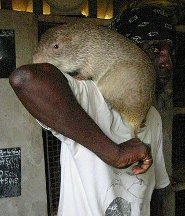
There are two species of the cane rat and the
Greater Cane Rat (
Thryonomys Swinderianus) is the larger among the two (surprisingly!). The length of the greater cane rat is about 67-79.2 cm (26.1-30.9 inches). It weighs around 5 - 6.5 kg (11-14.3 lbs). In few cases, these cane rats have been found to weigh as much as 9 kg (19.8 pounds). Males are generally larger, they have massive heads and a powerful and stocky body. They have small but broad fur-covered ears. The most striking feature of greater cane rats is that they have oversized, bright, and orange-colored incisor teeth. The coat has coarse, thick, and pointed hair that varies in color. It is brown on the upper side and the underneath color is much lighter. The color of genitals of a mature cane rat is orange. The hind feet are bigger than the fore feet and they have quite large and well-shaped claws.
The life span of greater cane rats in the wild is short but in captivity, they can survive up to four years of age. These cane rats are considered good swimmers and are found in the marsh areas near streams and rivers. They favor low-lying, marshy areas along riverbanks and streams where dense tall grass and reeds are found.
The greater cane rats are found in almost all the countries to the west of the Sahara Desert but is absent in rain forests and dry scrublands. They occur in Uganda, Kenya, Malawi, Tanzania, Zimbabwe, South Africa, Angola, Namibia, Mozambique, Botswana, Sudan, Gambia, and Cameroon.
The tender new shoots of elephant grass are the primary food of greater cane rats. They also feed on guinea grass, kikuyu, pennisetum grass, plant stems, and roots. They also eat fruits, nuts, and bark of trees in small quantities. They eagerly hunt for vegetables in the fields and are avid consumers of such crops as pumpkin, sweet potato, millet, peanuts, maize, cassava, sorghum, wheat, and cane sugar.
The greater cane rat is a nocturnal and solitary animal. It lives in family groups of adult males, females, and their young ones with the male rat being the dominant member of the group. The gestation period of these cane rats is 152 to 156 days and the female normally gives birth to 2 to 4 pups at a time. Greater cane rats get frightened easily and immediately run towards water to outsmart the predator, since they are excellent swimmers and thus, it is easier for them to escape any danger, once in water.
Like their other smaller counterparts, the greater cane rats are also considered a hazard to the food crops and are viewed as an important food source by humans. Since these animals are found in abundance in almost all places wherever the habitat is suitable for their survival, they are not considered as threatened.
Picture: A male Greater Cane Rat (Thryonomys swinderianus) in a breeding station in Owendo, Gabon,
You can help spreading the word about this animal by liking it on facebook
Permanent Link
Thursday 23 May 2013
Mantled Howler - The Noisemaker
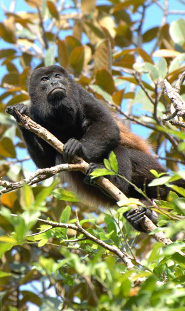
The
Mantled Howler (
Alouatta palliata), also called the Golden-mantled Howling Monkey, is a species of new world monkey in the howler monkey genus Alouatta. Their binomial name is Alouatta palliata, and they are a species that is of least concern on the IUCN redlist, meaning their populations are stable or growing (in the Alouatta palliata palliata subspecies and most common), unlike some of their relatives (the endangered Maranhão Red-handed Howler, and the endangered Guatemalan Black Howler being the two most at risk) however two of the subspecies of the Mantled Howler are endangered, and one of them is critically endangered. They have a black fur that covers their entire body; however they have a golden coloration upon each side which gives them their name. The Mantled Howler is one of the largest monkeys in the New World (specifically Central America and South America) with females reaching close to, or at two feet in length (63 cm), and males being over two feet (~65 cm) - added to that is a prehensile (usable) tail that measures an additional two feet (~64 cm) on average. Adult females can range in weight from seven to seventeen pounds (3-7kg) while adult males will usually come in heavier at ten to twenty two pounds (4.5-10kg). The weight of each monkey can vary depending on nutrition, location, and other factors related to where they are.
Their environment has pushed them to adapt to a mostly folivorous diet, which consists of leaves mostly (between half to three quarters of their daily food intake). The other portion of their diet consists of opportunistic feeding, such as when fruit or flowers are available. If enough fruit is available it can make up half or more of their diet at that given time, however otherwise they stick to leaves. These adaptations include both physical and behavioral. The molars of the Mantled Howler have shearing crests that are higher to help with the consumption of leaves. Their eyesight, unlike other New-world Monkeys, is tri-color (called trichromacy) which means they can see as well as we do, in order to distinguish between young and old leaves. Due to leaves being an extremely low energy food source, the males will make a howl to locate each other, rather than actually look; their distinctive call from the adaptation to a low energy diet: a modified hyoid bone allows for greater amplification of the calls made by males, which expends less energy - being comparable to if you were to talk normally. Some of the behaviors include resting for much of the time, and also being very selective about the leaves they eat, going for young leaves which are less likely to have toxins, and are easier to digest than mature leaves.
There are three known subspecies of the Mantled Howler.
The Ecuadorian Mantled Howler, binomial name
Alouatta palliata aequatorialis, is located in Columbia, Panama, Peru, Ecuador, and Costa Rica. They are listed as vulnerable and considered endangered due to habitat loss and poaching.
The Golden-mantled Howler, binomial name
Alouatta palliata palliata, is the most common and located in Costa Rica, Honduras, Nicaragua, and Guatemala. They are listed as a least-concern due to their healthy population.
The Mexican Howler, binomial name
Alouatta palliata mexicana, is only found in Guatemala and Mexico, they are critically endangered and close to extinction due to massive amounts of habitat loss, it is expected to lose more than 80% of its population within the next 3 generations and possibly be extinct after this. This subspecies is in extreme danger.
The species name is palliata, and there are three subspecies (as shown above). The Mantled Howler belongs to the Genus Alouatta of which all the other howlers belong, and Alouatta belongs to the Family Atelidae which is one of the four in the New World Monkeys. Within Atelidae are the howlers, the spider monkeys, the woolly monkeys, and some extinct relatives. Atelidae belongs to the Parvorder Platyrrhini, which includes all of the New World Monkeys, such as the world’s smallest monkey, the Pygmy Marmoset to the sakis, and the squirrel monkeys. Platyrrhini belongs to the Infraorder Simiiformes of which we are members, and all in this Infraorder are called simians. From here on out it is a journey to all of our mammal relatives, as Simiiformes belongs to Suborder Haplorrhini which includes tarsiers and other relatives. Haplorrhini belongs to the Order Primates which includes our relatives like the lemur. Primates are all Euarchontoglires, which is the Superorder we belong to, and that includes our extinct relatives the Plesiadapiformes, the colugos, the treeshrews, and more distantly (being the Glires) rabbits, hares, pikas, and rodents. Euarchontoglires evolved in the late Cretaceous, before the Dinosaurs went extinct, starting way back some 80-90 million years ago - of course 65 million years ago that changed as the Dinosaurs went extinct. Euarchontoglires belong to the Infraclass Eutheria (placental mammals) which belongs to the Subclass Theria (all but monotremes) and that belongs to the Class Mammalia (All mammals).
They are very athletic when the need arises, and their locomotion is determined by their environment. Aided by their prehensile tail they can navigate the trees they live in and will leap from one limb to another if it must. They are an arboreal, meaning they are a tree-dweller, in addition to being diurnal, active in the day, and they mostly climb, walk, or run with all four hands and feet. They usually don’t do anything if they don’t have to however, as they are an exceptionally lazy and inactive monkey due to their very low energy diet - they are nearly comparable to the sloth, as they spend most of their active period eating and their social time is less than five percent. They do live in groups, and they number around 20 to 40 members, and when a young monkey reaches maturity they are usually evicted.
Interesting facts about the Mantled Howler:
They may use tools, as relatives have been recorded shooing away sloths that decided to walk into their trees, such as sticks.
Picture of the mantled howler © by Leonardo C. Fleck, licensed under
GFDL
You can help spreading the word about this animal by liking it on facebook
Permanent Link
Wednesday 22 May 2013
Bobak Marmot - The Social Steppe Marmot
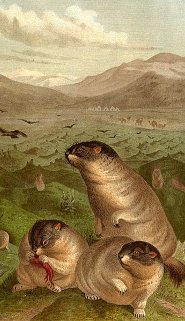
The
Bobak marmot (
Marmota bobak) inhabits the prairies and grassland plains of Central Asia, the Ukraine, and Russia. Also known as the steppe marmot, the animal can thrive in areas that most other species cannot such as at the outer edges of cultivated fields.
The Bobak marmot resembles the
North American prairie dog. Its most notable characteristics are its round belly, short, stubby legs, and short tail. The length of a Bobak marmot is approximately 24 inches (60 cm), and the weight is around 11 pounds (5 kg). In general, the males are slightly larger than the females. The coat of this prairie dweller is short and thick with longer, darker hairs that jut out beyond the underfur. These darker hairs are prominent between the eyes and on the top of the head. The tail, underbelly, and throat is also generally darker than the rest of the body. In the fall, adult marmots are soft yellow with a dark brown topcoat. During the summer, the sun lightens the coat even more.
Young Bobak marmots feed on the female’s milk for the first couple months of life, and adult marmots feed on wild prairie grasses. Wheatgrass, knotgrass, chicory, clover, and wild oats are the typical meals of the marmot. Occasionally, marmots will graze on sunflowers, crops, and vegetable gardens. Feeding increases prior to winter hibernation and in early spring.
When it is not in hibernation, the Bobak marmot has a remarkably active social life for nearly half the year. In general, each family may have up to five adults and six young. As many as fifteen families can prosper in one square kilometer. Marmots are most active during dawn and dusk, and they spend up to sixteen hours socializing. Mating occurs in early spring, and nearly sixty percent of the females breed each year. Females also act as guards for the colonies. The guard marmot stands erect while searching for danger. If a predator nears, the guard sounds a warning call to the other marmots.
Bobak marmots are prey to foxes, wild dogs, and eagles. Marmots were once hunted for their thick pelts, however hunting and trapping have been prohibited in many regions. Bobak marmots are considered to be at low risk for endangerment. The marmot can live up to fifteen years in captivity, but its longevity decreases in the wild.
You can help spreading the word about this animal by liking it on facebook
Permanent Link
Thursday 16 May 2013
Marbled Polecats - The Introverts
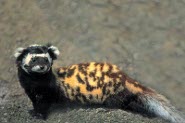
The small mammal, the
Marbled Polecat (
Vormela peregusna), belongs to the monotypic genus Vormela and is a member of Mustelinae subfamily. The word 'Vormela' comes from the German word 'Würmlein' depicting the size of the marbled polecat. The word 'Peregusna' has come from 'pereguznya', the Ukrainian word for 'polecat'. Marbled polecats can be found in the grasslands and dry areas of western China to the southern-eastern regions of Europe. When threatened, the anal sacs under its tail emit a secretion with a very strong smell.
The length of the polecat is generally between 29 and 35 cm. It has short limbs, short muzzle, very large ears, and long but strong claws. The polecat has a short structure as compared to its long, hairy tail. The face has black and white marks on it. There are black stripes across its eyes and white markings on its face. The other species of this family dorsally is yellow in color and there are brown and reddish spots all over its body. The color of the tail is dark brown and in the middle of the tai,l there is a yellowish band. The weight of the female polecat is generally 295g to 600g and the male polecat weighs about 320g to 715g.
The marbled polecat is generally found in China, Russia, and south-east Europe. The other regions where polecat is found include Romania, Lebanon, Syria, Bulgaria, Jordan, Palestine, Armenia, Israel, Iran, Asia Minor, Afghanistan, Yugoslavia, China, Mongolia, northern-western Pakistan, Altai Steppes in Siberia, and Kazakhstan. Marble polecats are also seen in Sinai Peninsula in 1998.
Marbled polecats are very active during the morning and the evening times. Since their eyesight is weak, their movement depends a lot on their powerful sense of smell. Their vocalization is quite limited and usually consists of shrill grunts, submissive long shrieks, and alarm cries. By nature, they prefer being alone and move in a radius of about 0.5 - 0.6 km from their homes. They generally do not stay at one place for more than once and are quite aggressive when encountering with other polecats.
When they sense any kind of danger, marbled polecats lift their legs, while at the same time, arch their back and curl their tail on their back with their long tail hair standing erect. They also given short, shrill hisses, cover their teeth, and lift their head. When threatened, marbled polecats sometimes release an extremely foul smell from their inflated anal glands located under the tail.
When digging or excavating dens, marbled polecats use their forelegs to dig the earth and anchor themselves using their hind legs and chin. They make use of their teeth to weed off obstacles like roots and grass while digging.
Marbled polecats generally feed on ground squirrels, Armenian hamsters, mole rats, voles, Libyan jirds, frogs, lizards, hares, fish, birds, pigeons, chickens, house mice, and insects such as crickets, beetles, snails, and so on. They have also been found to stealing cheese and smoked meat in houses.
Picture of the marbled polecat, Courtesy of Photographer: Laszlo Szabo-Szeley ©AVESTOURS
You can help spreading the word about this animal by liking it on facebook
Permanent Link
Wednesday 15 May 2013
The Health-Conscious Jamaican Fruit-eating Bats
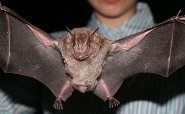
The
Jamaican fruit-eating bat (
Artibeus jamaicensis) is also known as the Mexican or Common fruit-eating bat. The Jamaican fruit-eating bat is found in South and Central America. Although not very common, it is found in the Southern Bahamas as well. Its most distinctive feature is that its external tail is missing and it has a U-shaped and a very minimal interfemoral membrane. It has a grayish brown coat and its underside is slightly pale. It leaves mild and soap-like odor and has a nose that looks like its third ear. Unlike other bats, its ears are pointed at the ends. The Jamaican fruit-eating bat is 9 cm (3.5 inches) in length.
It mainly dwells in deciduous scrub or rainforests. With the help of the leaves of Palmae and Araceae plants, it builds a type of tent. It is also found in caves, forest foliage, and hollow trees.
The Jamaican fruit-eating bat belongs to the set of nocturnal animals. As its name suggests, it likes eating fruits. It mainly feeds on cecropias, figs, papayas, bananas, and guavas. Sometimes, when fruits are not available, it also feeds on pollen, nectar, leaves and even insects as well. Sometimes, it has to fly for 10 to 15 miles at a stretch in search of fruit trees. After finding a fruit, it carries the fruit in its mouth and flies off to a dining perch to eat it. It bites into the fruit and to break it and get the juice, it presses it in the mouth. The rough roof of its mouth helps it to squeeze out the juice. After squeezing the juice, it breaks the fruit to eats its flesh. Fruits with big seeds are left, since it generally swallows small seeds.
One important fact about the Jamaican fruit-eating bat is that among mammals, it is considered quite efficient in food digestion. It takes this bat just fifteen minutes to process the food. This is the main reason that the small seeds which had been swallowed earlier are left undigested. The seeds are re-released which helps in the dispersing of seeds.
A thorough research is being carried out on the ecology of different bat species on Barro Colorado Island, a natural reserve run by Smithsonian Tropical Research Institute in Panama. Under the supervision of the scientist Elisabeth Kalko, over 10,000 individuals of the bat species were examined, measured and marked for the BCi project on bats being carried out under the supervision of Elisabeth Kalko.
The female of Jamaican fruit bat is known to bear only one young at a time. At higher elevations, the birth takes place only once a year while in Panama, it happens twice a year. Bearing two young ones at a time is very uncommon. February to July is usually the breeding period of the Jamaican fruit-eating bat. Usually, when it is its mating season, the birth of young ones is very rare and there is a very short period in a year when the birth is at its peak. Life expectancy of this species is very short, only two to three years on average.
Picture of the Jamaican Fruit-eating bat by Tobusaru, licensed under
Creative Commons Attribution 3.0 Unported.
You can help spreading the word about this animal by liking it on facebook
Permanent Link
Monday 13 May 2013
Silky Shrew Opossum - Tiny, Nocturnal Marsupial of The Andes

The
Silky Shrew Opossum (
Caenolestes fuliginosus) is a unique animal native to the cool, wet, heavy vegetated forest regions of the Andes Mountains of South America. Their live at altitudes from 4,500 feet to 12,000 feet (1,500 to 4,000 meters). The Silky Shrew Opossum is also called the Dusky Shrew Opossum, the Dusky Caenolestid or the Ecuadorean Shrew-Opossum. Its range extends from
Ecuador and
Colombia, across the northwestern forests of
Venezuela.
The Silky Shrew Opossum is a member of the marsupial family, in that, like kangaroos, they carry their young in a pouch.
It is a tiny animal, with a head and body measuring just 3.7 to 5.3 inches (9.3 to 13.5 centimeters) and tail length of 3.7 to 5.3 inches (9.3 to 12.7 centimeters). Unable to grasp with his tail, it will use it as a kind of third leg for balance, while standing upright. The animal is covered with a thick, soft fur of dark brown, with the undersides turning to a lighter tan color. The females are smaller, weighing in at .58 to .79 ounces (16.5 to 22.4 grams) and the males weighing .88 to 1.43 ounces (25 to 40.8 grams).
Silky Shrew Opossums thrive on a diet of caterpillars, spiders, centipedes and other insects, and some fruit. The animals forages for food on the ground at night, hiding in burrows or logs by day.
When threatened, a Silky Shrew Opossum will open his mouth wide and hiss at the intruder. Because of their nocturnal, solitary life in the mountains, they do not have very much interaction with humans. Therefore, not much is known about these tiny, nocturnal creatures.
The Silky Shrew Opossum is probably the most well known of the shrew opossum species. Because of their small size, any larger animal in its region could potentially be a predator. Although other Shrew Opossum species are endangered or threatened because of loss of habitat from deforestation, the Silky Shrew Opossum does not have any conservation standing at this time.
You can help spreading the word about this animal by liking it on facebook
Permanent Link
Thursday 09 May 2013
Asian Glossy Starling - the Community Bird
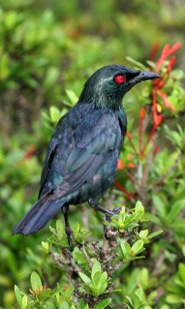
The
Asian Glossy Starling (
Aplonis panayensis), also known as the Philippine Glossy Starling, is a
bird in the Sturnidae or starling family. Both male and female birds have metallic, dark green feathers that can look black or purple. The eyes are bright red. Immature birds have an underside that is striped black and white, and upper feathers that are brownish-black. The bird is a medium sized, about 20 cm long. They have slim bodies and narrow wings, which help their flight, usually at tree-top level, to be swift and direct. The Starling family is considered one of the noisiest families of birds. The Asian Glossy Starling has a call like a short whistle when perched, and ringing or piping call when in flight. Like other birds in the Sturnidae family, they can mimic other sounds.
These birds are community oriented, and congregate in groups of around 20. The flock will roost in a tree together, feed together, and fly together. Before landing in a roosting tree, the flock will perform an intricate dance over the tree, flying in symmetrical patterns. The birds set up their nests near the rest of the flock, and brood all year long, mostly from March to June. They build nests in sheltered, elevated places, such as holes in trees or under eaves of man-made structures. Nests vary in intricacy from a little grass added to a hole, to detailed nests made from grass and paper. The female lays three dark blue eggs with brown spots.
Their diet consists predominantly of soft fruits, such as mango, papaya, and banana, as well as berries, figs, and insects. They prefer perching in trees, and rarely land on the ground. Only fallen fruit tempt them to the ground, and then they hop awkwardly.
The Asian Glossy Starling lives in India, Thailand, the Philippines, Indonesia, and the surrounding countries. The preferred habitat of this bird is tropical or subtropical moist lowland or mangrove forests. These birds do not migrate. A large population of the Asian Glossy Starling lives in cities, making nests in abandoned buildings and trees. This species has a endangered species status of least concern, as it has adapted well to human development. On fruit plantations, it is even thought of as an invasive bird.
Picture of the Asian glossy starling by Dr Yap Lip Kee, licensed under
Creative Commons Attribution-Share Alike 2.0 Generic license.
You can help spreading the word about this animal by liking it on facebook
Permanent Link
Wednesday 08 May 2013
Screaming hairy armadillo (Chaetophractus vellerosus)
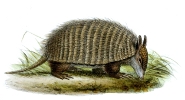
The
Screaming Hairy Armadillo (Chaetophractus vellerosus) is a burrowing mammal that belongs to the family of Dasypodidae. It is found in the western regions of Bolivia and northwestern areas of Argentina, especially in Monte Desert. It digs burrows in the desert, preferably in sloping sand dunes and also in savanna, grassland, and even scrub forests. The burrows are about a meter deep and extend to about several meters in length to protect the armadillo from the excessive heat of the sun.
The Screaming Hairy Armadillo has a built-in protective armor just like other armadillos. This is a shell composed of scutes or plates of thin bones. This armor includes the head shield, the shield on the neck's back between its ears, and the carapace protecting its back, shoulders, rump, and sides. Its carapace has a banded part with 6 to 8 bands movable from a total of 18. More hair, however, grows on the Screaming Hairy Armadillo compared to other species of armadillos. These hairs protrude outward from the body armor's scales. The animal's belly and limbs are full of light brown or whitish hairs. Meanwhile, the head and body length of this animal is from 220 to 400 millimeters, and the weight is 84 kilograms on the average. The length of its tail is from 90 to 175 millimeters. Females are usually smaller than males, but both of them become heavier by winter because of accumulated fat.
Interestingly, it is nocturnal during summer to escape the sun's heat. It solely leaves its burrow and searches for food at night. The armadillo is an omnivore, and its diet consists mainly of plants and insects, particularly beetles. In winter, it mainly feeds on vegetation, but in summer, it eats even snakes, rodents, lizards, and some other small vertebrates. It breeds in autumn with a gestation period that may last between 60 and 75 days. It usually produces two litters with both females and males becoming sexually mature after 9 months.
Interesting fact: The Screaming Hairy Armadillo, aside from its screaming hairs, emits a very loud squeal when threatened, hence its name.
You can help spreading the word about this animal by liking it on facebook
Permanent Link
Tuesday 07 May 2013
South Africa's Tiny Bouncing Oribi Antelope
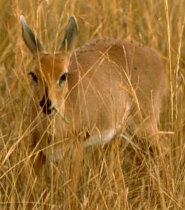
The
Oribi (
Ourebia ourebi) graze the floodplains and wide open grasslands of South Africa along the northern section of the eastern coastline of the cape. The Oribi are considered by avid naturalists to be a pure and true grazer who survives mainly on young sprouts and other flora for sustenance.
The average animal measures approximately 100 centimeters (45.4 inches) in length and weighs roughly 15-20 kilograms (33-44 pounds). Interestingly, Oribi rams are stouter in stature than ewes. Oribi rams boast horns which are on average over 100 millimeters (4 inches) in length and are ringed at the base of the antler. Also, Oribi rams use pre-orbital glands in order to mark their territorial boundaries. But as a species, the Oribi population is at best scattered and sparse.
Oribi, distinguished by a black tail and white accents around the animal's snout, achieve its peak breeding period during the months of November and December. The incubation period for a single Oribi lamb is approximately 210 days as well according to the most up to date biology on this species of South African antelope. Oribi live their lives monogamously, often seen traversing the grasslands alone or in pairs. The typical Oribi "family" consists of a ram and as many as two ewes.
Some of the rather colorful characteristics of the Oribi antelope of South Africa include the animal's comical oval shaped ears and thin, slim legs and hindquarters. The fur of an Oribi is tinted from brownish to yellowish hues, which allow the animal to better hide from the many infamous African predators in the region.
In fact, because of their small stature, the Oribi are more apt to run and hide at the first sign of danger. When startled by predators, the Oribi emits a high-pitched shriek and undergoes a unique display known as "stotting", which occurs when a beast with straight legs leaps vertically rather than laterally. Some of the Oribi's primary predators include the large cat species like
leopards and
lions as well as
hyena.
Due to a sparse population and changes to the Oribi's habit grasslands, the tiny Oribi remain on the African endangered species list. In fact, most of the Oribi accounted for in South Africa reside on privately held lands. Few of the Oribi roam open, protected lands.
You can help spreading the word about this animal by liking it on facebook
Permanent Link
Thursday 02 May 2013
'I'iwi - Partner in Avian Preservation
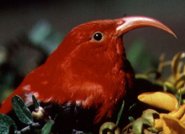
The
'I'iwi (
Vestiaria coccinea) is a bright red orange
bird with similarities to hummingbirds found in Hawaii. They drink nectar of Hawaiian lobelia flowers with their long bills, but unlike hummingbirds, their bills are curved. They will also dine on small crustaceans, butterflies, and other insects if nectar is hard to find. They can also hover like hummingbirds. Another name for them is the Hawaiian honeycreeper.
Many have seen old pictures of Hawaiians wearing feathered capes and head dresses in bright red. Those feathers are from the 'I' iwi when it becomes an adult. It is only a matter of 2 weeks before the eggs are hatched. Adulthood is reached almost as rapidly in less than a month. They grow to about 15 centimeters or almost 6 inches in length, and weigh about 17 grams or about half an ounce. When newly hatched, their down is pale lime colored with rusty splotches. As this grows out, they molt into their adult coloring. They have black wings and with very little white near their wing area. Their legs are even bright red orange.
The little birds' survival rate is better in high altitudes because the mosquito population that causes avian malaria is not present there. When migrating to lower altitudes, they may face other avian diseases. Land and habitat alterations have also declined numbers. Because of maladies faced, they are extinct on one Hawaiian island and only survive in higher numbers on two others. One way scientists are trying to preserve the species is by elimination of non-native environmental factors. Predatory feral cats and rats are two other hazards of the 'i'iwi.
Besides its own existence, it has been used to help other native species of birds that may be in peril in the Hawaiian islands, such as the endangered akohekohe bird. Scientists captured 'i'iwi birds using two ways called hard and soft methods. Each was studied to see survival rates of reintroduced birds. Hard method was a quick catch, tag, and release to a new area, whereas, soft method added a period of week long captivity and feeding of artificial nectar before release. Radio monitors traced information from the released birds, and used to relocate akohekohe to try to build their populations, too. The scientific community is in hopes that both of these birds' numbers will increase enough that they will no longer be considered endangered to the world.
You can help spreading the word about this animal by liking it on facebook
Permanent Link
Wednesday 01 May 2013
Golden-rumped Elephant Shrew
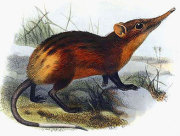
The
Golden-rumped Elephant Shrew (
Rhynchocyon chrysopygus) is named after its unique golden-hued fur at the rump's area. Just like its relatives, the snout of Golden-rumped Elephant Shrews are flexible and pointed. A Golden-rumped Elephant Shrew's coat is rough but glossy. A thick skin exists under the rump, and is three times as thick as the skin on the back's middle, and this forms as a kind of shield for the Golden-rumped Elephant Shrew. Experts and researchers say that this is a shield against the biting of another shrew when they fight.
They are found in coastal areas, and they would most probably be found in moist forest areas and in semi-deciduous forests. Actually, these shrews are among the biggest of the elephant shrew world. They are endemic to Kenya, but a scattering could be found in areas of Mombasa and the Somali border territories.
They are basically monogamous, couples reside in ranges and they are territorial when it comes to these homes. Diurnal in nature, they could sleep during the night at a nest on the forest ground. The Golden-rumped Elephant Shrew's diet consists of worms, insects, millipedes and even spiders. They of course forage on the forest/jungle floor via their flexible noses. When they are not busy eating, they could be very busy running for their lives though. A Golden-rumped Elephant Shrew has its share of predators, such as eagles, cobras and the black mambas.
Interesting fact: If you would be lucky to see one in actual movement, you might be impressed. These shrews can go to speeds reaching 25 kilometers/hr if chased by a predator.
You can help spreading the word about this animal by liking it on facebook
Permanent Link
 There are two species of the cane rat and the Greater Cane Rat (Thryonomys Swinderianus) is the larger among the two (surprisingly!). The length of the greater cane rat is about 67-79.2 cm (26.1-30.9 inches). It weighs around 5 - 6.5 kg (11-14.3 lbs). In few cases, these cane rats have been found to weigh as much as 9 kg (19.8 pounds). Males are generally larger, they have massive heads and a powerful and stocky body. They have small but broad fur-covered ears. The most striking feature of greater cane rats is that they have oversized, bright, and orange-colored incisor teeth. The coat has coarse, thick, and pointed hair that varies in color. It is brown on the upper side and the underneath color is much lighter. The color of genitals of a mature cane rat is orange. The hind feet are bigger than the fore feet and they have quite large and well-shaped claws.
There are two species of the cane rat and the Greater Cane Rat (Thryonomys Swinderianus) is the larger among the two (surprisingly!). The length of the greater cane rat is about 67-79.2 cm (26.1-30.9 inches). It weighs around 5 - 6.5 kg (11-14.3 lbs). In few cases, these cane rats have been found to weigh as much as 9 kg (19.8 pounds). Males are generally larger, they have massive heads and a powerful and stocky body. They have small but broad fur-covered ears. The most striking feature of greater cane rats is that they have oversized, bright, and orange-colored incisor teeth. The coat has coarse, thick, and pointed hair that varies in color. It is brown on the upper side and the underneath color is much lighter. The color of genitals of a mature cane rat is orange. The hind feet are bigger than the fore feet and they have quite large and well-shaped claws.
 The
The  The
The  The small mammal, the
The small mammal, the The
The  The
The  The
The  The
The  The
The  The
The  The
The